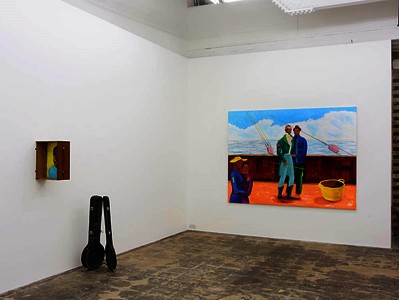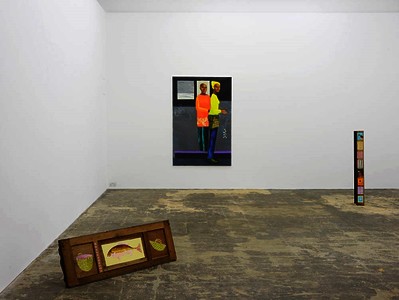Himid, Lubaina (2018) 'The Tenderness Only We Can See' Hollybush Gardens, London 2018. [Show/Exhibition]
![Installation shot [thumbnail of Installation shot]](https://clok.uclan.ac.uk/22969/1.hassmallThumbnailVersion/lh5.jpg)  Preview |
Image (JPEG) (Installation shot)
- Cover Image
Available under License Creative Commons Attribution Non-commercial No Derivatives. 90kB |
![installation shot [thumbnail of installation shot]](https://clok.uclan.ac.uk/22969/2.hassmallThumbnailVersion/lh6.jpg)  Preview |
Image (JPEG) (installation shot)
- Supplemental Material
Available under License Creative Commons Attribution Non-commercial No Derivatives. 88kB |
Official URL: http://hollybushgardens.co.uk/?page_id=14754
Abstract
The work in this exhibition engages with how to make paintings that are speaking different languages to me and to each other; some of them are secret. It draws on other lines of communication in an attempt to hold the inner narratives together. Using four music related objects to navigate the exhibition space the meaning within the objects history becomes a narrative force in the exhibition.
The eponymous The Tenderness Only we Can See is a painting on a piano part. Like an altarpiece the picture surface is partitioned in three parts, at the centre a fish in yellow, brown and pink on a light yellow background is surrounded by baskets. Chopin’s Heart, a piece of piano standing column-like, contrasts birds and patterns as if in a fabric sample book. Plants and animals, like patterns, traverse time and key into our register of recognition, assumption and place of cultural belonging. Painting British fish, for instance, is a strategy for recasting notions of the exotic, deconstructing that which is familiar, turning the everyday into ‘other’. The sh is silent whereas the pattern speaks a secret language. The baskets are women’s companions and familiars. The piano in contrast to a banjo is an instrument that straddles bourgeois drawing room entertainment, the concert hall, jazz club and more.
Another painting, The Captain and the Mate expands on a long-term interest in the work of James Tissot (1832 – 1902). Since the early 90s Himid has been recasting paintings from his period of painting fashionable women, replacing white figures with black figures, suggesting alternative stories that could have been concurrent, but that also operate in their own time space continuum. Whilst far removed from the original, the pulleys on the ship have been faithfully painted – the mechanisms in the painting asking for as much attention as the drama unfolding in front of us; oblivious of their audience, the figures are caught up with each other. If we think about the Tissot painting this might be a scene of adieu, an anxious moment of heightened emotional charge. Or it could be that the new pairings evoke another set of relations entirely, relationships that cross heteronormative pictorial space and gender identification. Like in previous bodies of work, the painting demonstrates a commitment to clothing and fashion; the protagonists are well dressed, either expensively or fashionably. A simple singular yellow stick held by the captain offers an aspect of theatre to the mis en scène, cutting through the picture plane, it seems both provocative and benign, emblematic of power or merely of dress.
In Her Print on Me the role of the audience has moved from curious observer to unwelcome visitor, bringing the fictional world of the painting into our reality. Interrupted, something falls from the hands of the foregrounded woman, the sketchy chair and the large windows serve to increase the feeling of vast space emoted by the wild sea that functions in opposition to the calm gaze of the women. The bodies of the women, separated by a long beam dividing the space, are poised as if in the middle of a task or a ritual. They face an unwelcome interlocutor in the form of our gaze set in their intimate scenario. This painting evokes a constant preoccupation of Himid’s; the dialectic of safety and danger. As she would say “Somehow it’s very challenging to tell the difference between the two.”
A drawer, another found object that Himid returns to, provides a surface for two male portraits. Drawers act metaphorically perhaps, but also offer a performative aspect to the paintings, the placement of the drawer itself as well as the hiding and revealing of the body, and like Himid’s earlier ‘paintings on wood’, these works offer the possibility of being looked at in different ways by placing the draw this way or that.
Repository Staff Only: item control page

 Tools
Tools Tools
Tools
